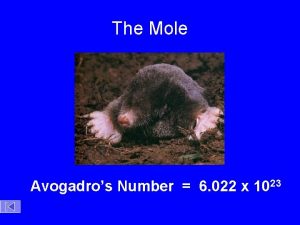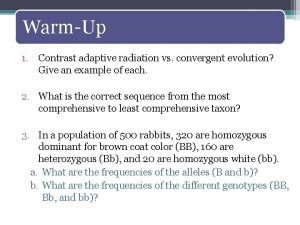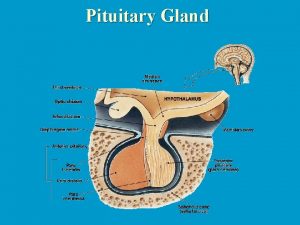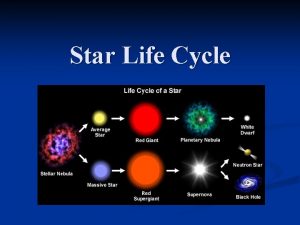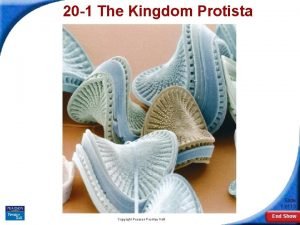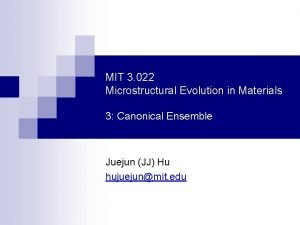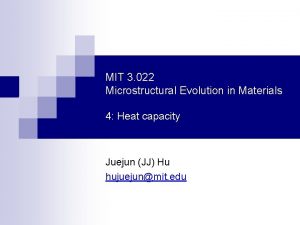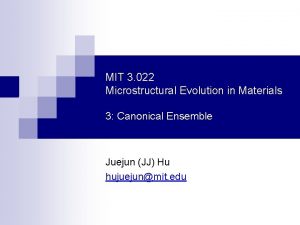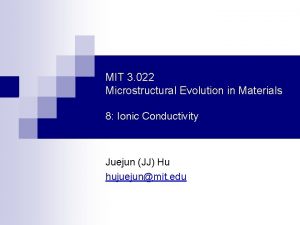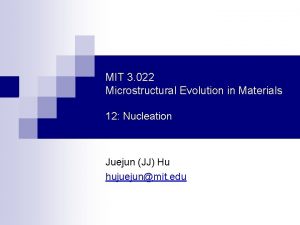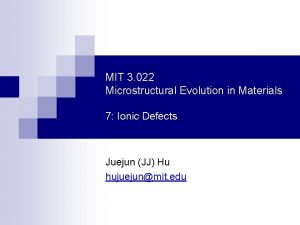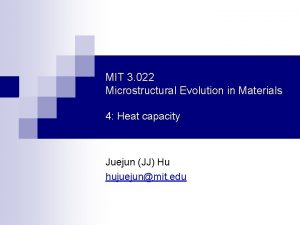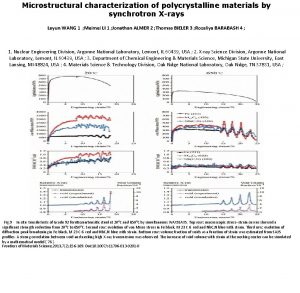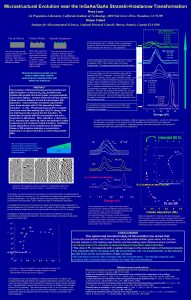MIT 3 022 Microstructural Evolution in Materials 7



























- Slides: 27

MIT 3. 022 Microstructural Evolution in Materials 7: Ionic Defects Juejun (JJ) Hu hujuejun@mit. edu

Gas sensor © safety. com © Consumer Reports Fuel cell Defects are not always bad Solid state battery The Midas touch By Peter Welleman © Butterfield Jewlers

Charge neutrality n Macroscopic electroneutrality n Consider a sphere made of sodium with radius R = 1 cm. What is the energy needed to remove 0. 01% of valence electrons from the sphere? Site ratio conservation n The ratio of the number of regular cation sites to the number of regular anion sites remains constant n Mg. O crystal # Mg = # O

Ionic defect types A. Schottky defect (vacancy) A B. Frenkel defect (selfinterstitial) C C. Substitutional atom B D. Foreign interstitial D

Kroger-Vink notation n General form: n M – atom type; “V ” denotes vacancy n L – site in the original perfect lattice; “i ” denotes interstitial n C – effective charge (or relative charge), equaling to the difference in valence between the species on the site L and the atom that occupies the site in a perfect crystal ¨ Positive effective charge ¨ Negative effective charge ¨ Neutral defect n Quasi-free electron is denoted by ; hole is denoted by n Square brackets denotes defect fraction, e. g.

Examples of Kroger-Vink notation n Frenkel defect n Schottky defect n Substitutional atom n Foreign interstitial

Concentration of Frenkel defects n Configurational entropy Assume that there is one interstitial per lattice site Dislodge n atoms Place the atoms from their sites into n interstitials n Gibbs free energy n Equilibrium fraction of Frenkel defects

Equilibrium constant of defect reactions n Frenkel defect formation n General defect reactions e. g. DGf : Gibbs free energy of defect formation minus the configurational entropy term

Charge compensation in ionic solids n List all possible defect reactions when Ti. O 2 is doped into Al 2 O 3 and determine the defect concentrations 1) List all charged species Native vacancies: Foreign substitutional atom: Interstitials: 2) List defect reactions based on charge compensation pairs Schottky defect

Charge compensation in ionic solids (cont’d) 2) List defect reactions based on charge compensation pairs Frenkel defect Foreign substitution Foreign interstitial

Charge compensation in ionic solids (cont’d) 3) Combine all equations along with the overall charge neutrality condition to solve defect concentrations 5 equations, 5 unknown variables: a unique solution set Question: is mass conservation taken into account?

Charge compensation in non-stoichiometric solids n List all possible defect reactions in non-stoichiometric Ti. O 2 and determine the defect concentrations 1) List all charged species Native vacancies: Electrons and holes: 2) List defect reactions based on charge compensation pairs (1) (2) (3) (4) Not all reactions are independent: (4) = (1) + 4 × (2) – (3)

Charge compensation in non-stoichiometric solids 3) Combine all equations along with the overall charge neutrality condition to solve defect concentrations Non-degenerate semiconductors The defect concentration depends on oxygen partial pressure

Defect concentration: examples Schottky defect Frenkel defect Electron-hole pair DH (e. V) Eg (e. V) Mg. O 6. 6 Ca. F 2 2. 8 Si 1. 11 Ca. O 6. 1 Sr. F 2 2. 3 Ge 0. 67 Li. F 2. 34 Ba. F 2 1. 9 Mg. O 7. 8 Li. Cl 2. 12 Ag. Cl 1. 6 Ca. O 7. 1 Li. Br 1. 8 Ag. Br 1. 2 Zn. O 3. 2 Li. I 1. 3 b-Ag. I 0. 7 a-Ti. O 2 3. 0 For Mg. O at 1, 000 K:

Defect concentration: examples Schottky defect Frenkel defect Electron-hole pair DH (e. V) Eg (e. V) Mg. O 6. 6 Ca. F 2 2. 8 Si 1. 11 Ca. O 6. 1 Sr. F 2 2. 3 Ge 0. 67 Li. F 2. 34 Ba. F 2 1. 9 Mg. O 7. 8 Li. Cl 2. 12 Ag. Cl 1. 6 Ca. O 7. 1 Li. Br 1. 8 Ag. Br 1. 2 Zn. O 3. 2 Li. I 1. 3 b-Ag. I 0. 7 a-Ti. O 2 3. 0 For Mg. O at 1, 000 K:

The Brouwer approximation n One charged defect of each sign dominates over all others n Example: charge compensation in undoped Mg. O ¨ Regime 1: High oxygen partial pressure ¨ Regime 2: Low oxygen partial pressure ¨ Regime 3: Schottky compensation ¨ Regime 4: Electronic compensation Solve the charge carrier concentrations in each regime at one specific temperature

The Brouwer approximation (cont’d) n Equilibrium constants n High oxygen partial pressure regime:

The Brouwer approximation (cont’d) n Low oxygen partial pressure regime: n Schottky compensation regime (intermediate oxygen partial pressure):

log (defect concentration)

Brouwer diagram for doped crystals n Example: Al-doped stoichiometric Mg. O ¨ Neglect electronic carriers ¨ The primary defect in intrinsic Mg. O is Schottky defect ¨ Al-substitution of Mg dominates over interstitial formation (1) n Charge compensation regimes (dependent on Al concentration) ¨ Regime 1 (intrinsic): ¨ Regime 2 (extrinsic): (2)

Intrinsic Extrinsic log (defect concentration)

You can “see” ionic defects: F-centers in Na. Cl crystal: electron trapped at an anion (halide) vacancy Na Cl Na. Cl KBr http: //education. mrsec. wisc. edu/background/F_center

Q & A about g-ray irradiated table salt n n Is it still edible? ¨ Yes. First of all, I tried it. Tastes just like regular table salt. ¨ Secondly, irradiated salt only contains a small fraction of vacancy defects [in the order of 1017 cm-3 according to J. Appl. Phys. 31, 1688 (1960)]. Since the crystal will ionize when dissolved, these point defects don’t make a difference. ¨ Lastly, g-radiation normally does not trigger nuclear reactions [Nelson et al. “Gamma-Ray Interactions with Matter”], so we don’t need to worry about induced radioactivity. Okay, it is fun – but why do we need to care? ¨ Table salt and doped salt are useful materials for radiation dosimetry. See for example: Radiat. Meas. 46, 1856 (2011).

Understanding defect reactions Site ratio conservation Charge neutrality Equilibrium constant Frenkel & Schottky concentrations Kroger-Vink notation Doping & nonstoichiometric defects Defect concentration Brouwer approximation Brouwer diagram

List of symbols n Q – electric charge n C – capacitance (note the difference with C, Coulomb, unit of electric charge) n e 0 – vacuum permittivity (8. 85 × 10 -12 F/m) n e – elementary charge (1. 602 × 10 -19 C) n E – energy n T – temperature n k – Boltzmann constant (1. 38 × 10 -23 m 2 kg s-2 K-1) n n – number of point defects in a solid (slide 7) or free electron concentration (in the discussion of defect equilibrium)

List of symbols n DSc – configurational entropy change due to formation of a point defect n xf – fractional of lattice sites populated with Frenkel defects n DGf – Gibbs free energy change due to formation of a Frenkel defect minus the configurational entropy contribution n K – equilibrium constant of a defect reaction n p – hole concentration n NC / NV – effective density of states of conduction / valence band

List of symbols n Eg – band gap energy n N – number of atoms in a solid
 Culpabilidade direito penal
Culpabilidade direito penal Tel 022
Tel 022 6 022 x 10^23
6 022 x 10^23 Natural materials and man made materials
Natural materials and man made materials Adapting and adopting materials
Adapting and adopting materials Go noodle cant stop the feeling
Go noodle cant stop the feeling Direct materials budget with multiple materials
Direct materials budget with multiple materials Example useful and harmful materials
Example useful and harmful materials Evolution des ponts
Evolution des ponts What is fungi characteristics
What is fungi characteristics Adaptive radiation vs convergent evolution
Adaptive radiation vs convergent evolution Evolution of healthcare information systems
Evolution of healthcare information systems Chapter 18 the evolution of invertebrate diversity
Chapter 18 the evolution of invertebrate diversity History of banking sector in india
History of banking sector in india Prolactin hormones
Prolactin hormones Objective of eia
Objective of eia Fossil record defintion
Fossil record defintion Evolution of knowledge management
Evolution of knowledge management Stages of stellar evolution of a low-mass star
Stages of stellar evolution of a low-mass star Acromégalie bogdanov
Acromégalie bogdanov Evolution of populations section 16-1 genes and variation
Evolution of populations section 16-1 genes and variation Theory of evolution summary
Theory of evolution summary Pocket mouse evolution
Pocket mouse evolution Copyright
Copyright Evidence of evolution
Evidence of evolution Identify early ideas about evolution
Identify early ideas about evolution Evolution bell ringers
Evolution bell ringers Evolution of vlsi
Evolution of vlsi


